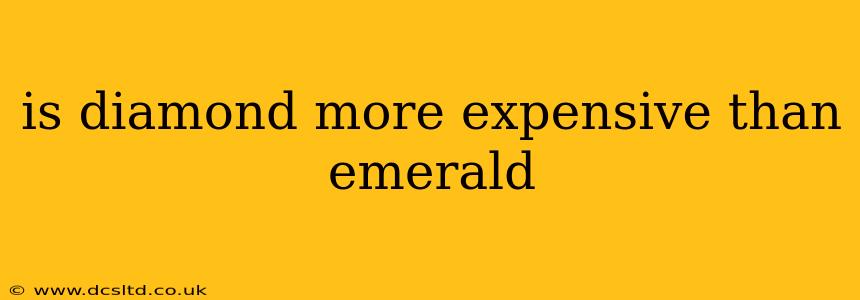Is Diamond More Expensive Than Emerald? A Deep Dive into Gemstone Value
The question of whether diamonds are more expensive than emeralds is a complex one, with no simple yes or no answer. While diamonds are generally perceived as more expensive on average, the actual price depends on a multitude of factors impacting both gemstones. This article will delve into these factors to give you a complete understanding of gemstone valuation and help you determine which is "more expensive" in various contexts.
What Factors Determine the Price of a Diamond?
Several critical factors influence a diamond's price, often summarized by the "4 Cs":
-
Cut: This refers to how well a diamond's facets interact with light, influencing its brilliance, fire, and scintillation. An expertly cut diamond will be far more expensive than a poorly cut one, even if they have the same carat weight and clarity.
-
Clarity: Clarity describes the presence of inclusions (internal flaws) and blemishes (external flaws). Flawless diamonds are exceptionally rare and command significantly higher prices.
-
Carat: Carat refers to a diamond's weight, with one carat equaling 200 milligrams. Larger diamonds are generally more expensive, although the increase isn't always linear.
-
Color: Colorless diamonds are the most valuable, with slight tints of yellow or brown decreasing value. However, fancy colored diamonds (e.g., pink, blue) can be exceptionally expensive depending on intensity and saturation.
What Factors Determine the Price of an Emerald?
Emeralds, similarly, are priced based on several key characteristics:
-
Color: The most important factor is color. Vivid green emeralds with intense saturation are highly prized. A slightly bluish or yellowish tint can significantly reduce an emerald's value.
-
Clarity: Emeralds almost always contain inclusions. While completely flawless emeralds exist, they are exceptionally rare. The type, size, and distribution of inclusions impact the price. Inclusions are often accepted as part of the emerald's character, though severe fracturing can detract from value.
-
Cut & Carat: Similar to diamonds, the cut influences how light interacts with the stone, affecting its brilliance. Carat weight also plays a role, with larger, high-quality emeralds fetching higher prices.
-
Treatment: Many emeralds undergo treatments to enhance their color or clarity. While some treatments are acceptable, others can significantly impact value.
So, Which is More Expensive: Diamond or Emerald?
On average, high-quality diamonds tend to fetch higher prices than high-quality emeralds of comparable carat weight. However, exceptional emeralds with superb color and clarity can surpass the value of diamonds of similar size. A small, flawless diamond might cost less than a large, vibrant emerald with noticeable inclusions. The price difference isn't solely determined by the type of gemstone but by its individual characteristics.
Are there other factors influencing price?
Yes, several other factors can influence the price of both diamonds and emeralds:
-
Origin: The mine of origin can impact price. Diamonds from certain mines are considered more prestigious and thus more expensive. Similarly, emeralds from Colombia are generally considered the finest and command higher prices.
-
Certification: Gemological certificates from reputable labs (like GIA for diamonds and AGL for emeralds) add to the value and provide buyer confidence.
-
Market demand: Current market trends and demand can influence prices for both diamonds and emeralds.
-
Setting: The quality and design of the setting can also impact the overall price of a piece of jewelry.
In conclusion, a definitive answer to whether diamonds are more expensive than emeralds is impossible without considering the specific characteristics of each stone. The individual qualities of cut, clarity, color, carat, origin, treatment, and market demand determine the final price. Always consult with a reputable gemologist or jeweler for accurate valuation.
